

Bromeliads make great plants for the paludarium or vivarium. They are easy to grow, being tolerant of humid conditions, and look very attractive when attached to branches and cork. They are very common in rainforests, typically living epiphytically on trees. Moisture gathers in the axials of these plants, and anybody that keeps poison dart frogs will be aware that the tadpoles of many species actually spend the first few weeks of their lives in these minute bodies of water high up in the forest canopy. There are over 3000 species of bromeliads from 57 different genera, and although a few are widely available, the vast majority will rarely or never be offered for sale.
Shop bought bromeliads are generally sold in pots, but this is more about keeping the plant upright rather than keep it watered. When using these plants in a paludarium, they can be pinned or tied into place onto woodwork, or a living wall to create superb specimen plants amongst other smaller leaved foliage. Bromeliads are typically inexpensive to buy and are widely stocked in home and garden stores, with an ever growing supply available online.
Bromeliads are famous for storing rainwater in their overlapping leaf bases - and these can be homes to numerous animals from insects to amphibians. Poison arrow frogs are possibly the best known example; the tadpoles are deposited into these tiny bodies of water, and this is where they remain until they emerge as frogs. A tank regularly misted with rainwater will replicate their natural environment very nicely. But more than this, their thick rubbery leaves create extra surfaces to support the tanks occupants, and nooks and crannys within which to hide.
In general these plants are quite tough, though older shop-bought plants do not always adapt to the new conditions of a humid vivarium so well. Try and keep them in a humid environment, but not too wet. A sure sign of too much humidity/insufficient ventilation is the rotting of leaves, which will turn brown and fall of. The roots of these plants must be allowed to dry out periodically. Although there is plenty of moisture in the rainforest canopy, there is also plenty of ventilation. These tend to do better when planted higher up in tall tanks, away from the most humid parts.
Of course, during the wetter seasons, rainwater will regularly fall onto these plants, and fill the axials. A good misting can simulate this, which also helps keeps leaves clean if frogs use the leaves as perches. It is important not to use tap water for this, as disolved salts will harm the plant. Reverse osmosis, distilled, or rainwater is essential. In general when misting a rainforest paludarium, tap water would not be used anyway.
Many tanks have wetter and drier areas, and it may be necessary to move your Bromeliad, or increase ventilation if it does not seem happy where it is. In nature these plants experience dryer periods in winter, and it is far more likely that a plant will be damaged from too much water than too little. If you have an automatic misting system, spray nozzles can be pointed towards or away from the plants as required. In some smaller set-ups, or tanks with a considerable water component, it can be difficult to keep Bromeliads healthy for the long term, and they may benefit from periodic holidays from the tank. This should be borne in mind before a specimen is permanently mounted onto tank structures.
There are thousands of different types of Bromeliad, but not all are suitable for the vivarium or paludarium. Firstly, many can grow very large. If you have a small, or even medium tank, these plants can quickly outgrow their space. Secondly, some have serrated or spiked leaf edges. These can be dangerous for some paludarium occupants, and again these should be avoided. Great paludarium bromeliads are available though. The best epiphytic species include members of the genera Neoregelia, Tillandsia (air plants), and Vriesea, whilst Cryptanthus seem to be the best of the non-epiphytes. Some keepers tend to put younger, smaller plants in their tanks, and replace them as they grow too large, though there are some very small bromeliads in each genus. See below for examples of the smallest species, most suitable for vivarium and paludarium use.
Guzmania
Guzmania are good plants for the paludarium with attractive flowers, but generally plain foliage. They can still get too large for many vivariums. Look out for the 'Theresa' cultivar, which is certainly one of the smallest varieties. ebay | amazon
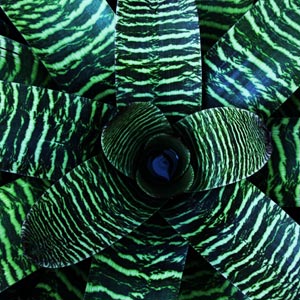 Vriesea leaves range from completely plain to heavily striped. Photo Nico Nelson
Vriesea leaves range from completely plain to heavily striped. Photo Nico Nelson
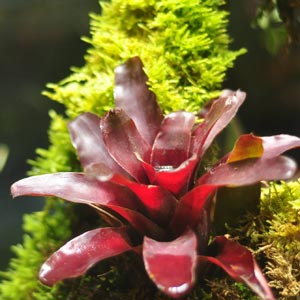 A beautiful Neoregelia with water filled cup. Photo Dũng Nguyễn Việt
A beautiful Neoregelia with water filled cup. Photo Dũng Nguyễn Việt
Vriesea
Vriesea is another excellent genus of bromeliads suitable for the paludarium. There is wide variation in leaf colour, and, again many species may be too large. Look out for 'Astrid' - an excellent cultivar under 6" tall. ebay | amazon
Neoregelia
Neoregelia compacta is another really small bromeliad, under 6" across. ebay | amazon
Neoregelia 'Pheasant' a gorgeous red plant, a cultivar, and again about 6" across, so small enough for any tank. ebay | amazon
Neoregelia 'Fireball' this lovely red plant is currently an undescribed species, however it's small size and beautiful foliage make it the perfect bromeliad for the smaller vivarium. ebay | amazon
Aechmea
Aechmea is less readily available than some other genera. Look out for the very small 'Suenos' cultivar, which is just around 8" tall when fully grown. This species has a wonderful pink/purple flower. ebay | amazon
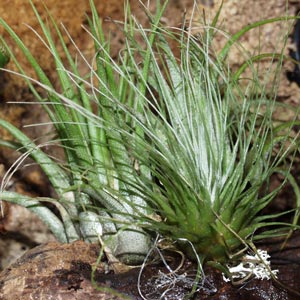
Tillandsia
Tillandsia represent somewhat of a special case when it comes to mounting. These air plants can actually lightly 'glued' into place with silicon aquarium sealant. Obviously don't try this within a tank already housing animals. They can also be wired or pushed into a hole. They will eventually root. Like other bromeliads, too much moisture will kill Tillandsia, so they should be mounted in the dryer regions of the tank, receiving only a light misting from time to time. Suggested species are Tillandsia stricta (ebay | amazon) and, perhaps the worlds smallest bromeliad, Tillandsia minutiflora (ebay | amazon)
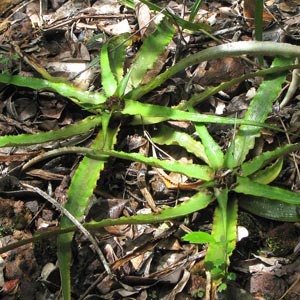 Wild growing Cryptanthus coriaceus Leme in Brazil, photo Alex Popovkin
Wild growing Cryptanthus coriaceus Leme in Brazil, photo Alex Popovkin
Cryptanthus
These bromeliads, unlike the forementioned types, are not epiphytes, and in nature grow rooted into the ground. In the paludarium they must also be planted. There are several very attractive members of this genus, but unfortunately many have spiked leaf edges, so not all are suitable to every enclosure. Smallest species include Cryptanthus bivittatus (ebay | amazon) and Cryptanthus beuckeri (ebay | amazon)
There are no doubt many more small bromeliad species, and new cultivars are being developed all the time. If you can suggest another small bromeliad, please comment.
The function of the wiry roots of these plants is primarily to attach them to a substrate rather than to absorb nutrients as is the case with typical rooted plants. In rainforests, the plants typically get wedged, perhaps in a fork in between two branches, and as the plant grows, the roots attach the plant firmly in position. It is important to make sure these plants are firmly fixed in place, especially if they will retain water (and hence increase in weight) or have animals using them as perches. In nature bromeliads can fall, but this is something that should be avoided in your paludarium.
Luckily, anchoring a bromeliad is easy. We want the roots to attach to woodwork, cork bark etc, and the roots will do so, just so long as the plant is held in place. So in reality if we can hold a plant in place for a month or two, it will attach itself. As is the case in the wild, wedging between two surfaces will help enormously, and look far more natural. Either a fork in a branch, or wedged between two fixed parallel sections. Simply tie, or wire the plant in place, wrapping over the roots primarily. Using natural looking twine will obviously improve the appearance of the mounted plant. A little sphagnum moss and a few bark chippings can be added around the roots to give the whole thing a more natural look, and to disguise the wire/string, however not under the roots. There is no point allowing the roots to attach to moss when the moss is not itself part of the substrate. Once the plant is established any mounting material can be removed, however if natural materials are used, hemp twine etc, they can simply be left in place to blend in with the plant roots, eventually biodegrading. Even more obvious, mounting materials can be disguised with moss / bark chips tucked in around the base of the plant.
As mentioned above, it can sometimes become essential to move a plant within the tank, or even give it a break from the tank entirely. For this reason it can be preferable to mount the plant on a piece of wood that is itself moveable. Another option is not to permanently attach the plant at all. Small 'pockets' can be created throughout the tank. These can be permanent glass or plastic cavities, typically disguised with cork bark, or even fabric - typically of natural fibres, sacking etc. Potted bromeliads can be placed into these repositories, again somewhat disguised with bark chips, coco fibre and sphagnum moss. In a well planted tank, these will barely be noticeable, but offer the advantage of easy removal of specimens. Keeping a selection of bromeliads in a greenhouse, for example, allows the paludarium keeper to swap out plants when needed, so the tank always looks great, but the plants are allowed to undergo the seasonal changes that they would experience in the wild.
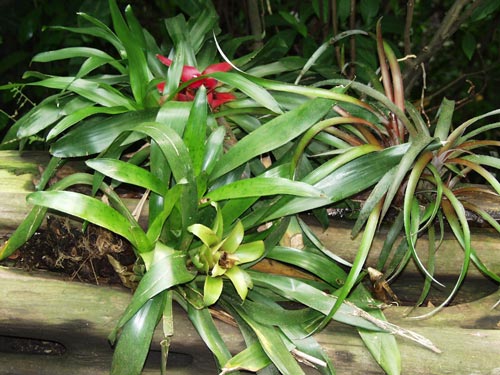
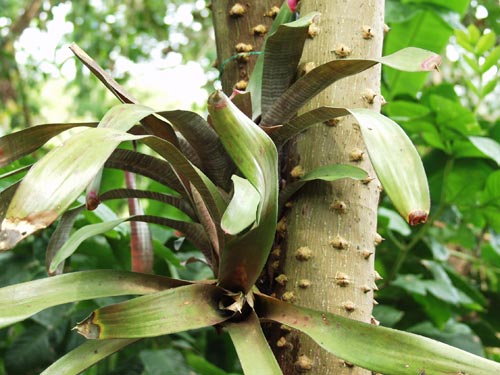
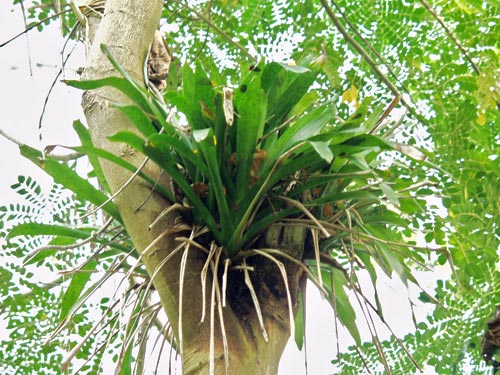
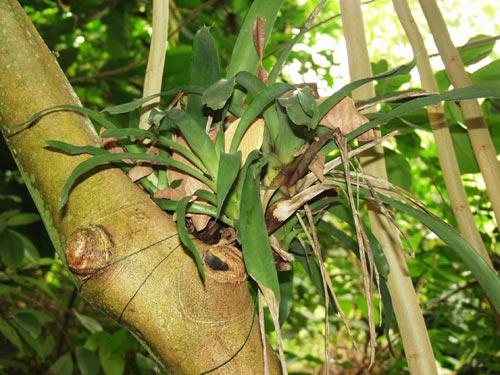
Some examples of larger bromeliads planted in the tropical rainforest biome at the Eden Project, Cornwall, UK. As can be seen each has been situated in a position that provides natural support independently from the roots own anchoring. The final image shows a plant still wired in place. Once the plant is firmly established this will be removed.
This wonderful 3 foot wide tank has a waterproof glass bottom, and adequate front window ventilation to keep the front glass clear. Although marketed as a Terrarium, it works as the perfect Paludarium. Front-opening doors, and removeable top for easy access and effective maintenance. Available in a wide range of sizes: with a larger surface area for ground/water dwelling species, or taller for leaf dwellers. Suitable for just about any paludarium inhabitant.
The top is equipped with closable inlets on both sides - this allows access for wires and tubing without offering an escape route for paludarium animals or the tiny invertebrates with which they are being fed. Suitable for powering Heat Wave rocks, waterfalls, filters and sensors, or injecting water through misting systems, external canister filters, etc.
All in all a great enclosure, providing a perfect environment for plants and animals, yet easy maintenance for the paludarium keeper. Available from Amazon and other good pet stores.